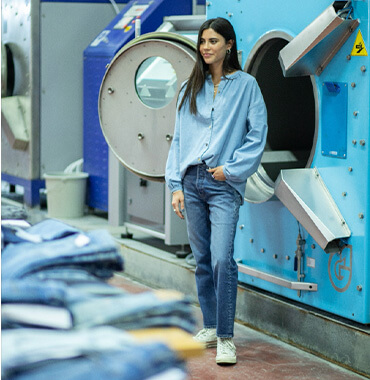Aftercare: Why Should The Supply Chain Care?
We’re continually searching for answers for the most eco-friendly way to produce denim, but we know that the most significant greenhouse gas generator is the use-phase in a product’s life cycle.
We’re continually searching for answers for the most eco-friendly way to produce denim, but we know that the most significant greenhouse gas generator is the use-phase in a product’s life cycle. How consumers use and care for their clothes is a huge determining factor in the entire carbon footprint of a garment, and now that we are generally aware of that, it’s time to start considering how the supply chain can better support the aftercare industry. I don’t know about you, but I was guilty of throwing saggy skinny jeans in the wash and dryer to shape them back up, and it pains me to admit I did. It wasn’t until I started educating myself on becoming a more conscious citizen that I learned that the dryer is the devil for your clothes. Now, the industry has found a solution to these problems with concepts like three-way stretch and continuing to improve stretch recovery, but we’ve almost been trained to think we need to wash and dry our denim every time we want a perfect fit. According to the Fashion On Climate report, garment care accounts for 30% of the carbon footprint of any individual piece of clothing, and how we care for our clothes and textiles really tell us what they mean to us. On average, we do ten loads of laundry per week. The carbon footprint of a load of laundry is 0.6 kg CO2e when washed at 30°C and dried on the line, 0.7 kg CO2e washed at 40°C and dried on the line, 2.4 kg CO2e when washed at 40°C and tumble-dried in a vented dryer, and 3.3 kilograms CO2e washed at 60°C and dried in a combined washer-dryer based on a full 5kg load. Of course, it depends on how you do it, but washing and drying a load every two days amounts to 440kg of CO2 each year. However, it isn’t entirely the fault of the consumer for overwashing or poor garment care. Our care habits have become extremely outdated, and with all the new technology out there, we should be taking advantage of it. According to AEG, the combination of obsolete care habits and fast fashion mindsets has led to 90% of clothing being thrown away before its full use has been maximized. Care labels are meant to educate the buyer on the best practice for keeping their purchase in use as long as possible. But, often, brands throw on “Dry Clean Only” to cover their butts for any laundering mishaps. Carrie Ellen Phillips for Vogue said, “Care labels protect the brand more than the clothing.” Dry-cleaning has relied on the use of perchloroethylene to fight hard stains and lifting grease, but it is harmful to our health and our environment. Although “perchloroethylene” might sound scary, the real problem with dry-cleaning is that it is overused and used for the wrong products. Throughout 2020, we saw many mills develop “virus-free” fabrics with antibacterial and antimicrobial finishes. These concepts are directly contributing to the idea of self-cleaning materials. Calik has specifically confronted this with their Washpro technology. Washpro technology promises long-lasting freshness for denim garments. Thanks to this advantage, end-users will need a smaller number of washes for their denim garment’s life cycle, WIth less washing means less water and energy and less microfiber pollution. Rudolf Group also presented WASH-LESS technology last year due to the GHG emissions generated during the consumer care stage, and encouraging product longevity. Care labels need to be straightforward and easy to understand so that all the work we do in the supply chain to create durable products isn’t lost. And this is the exact reason we must be in communication with the aftercare industry and engineer fabrics with aftercare in mind. Longevity and durability are the top most important qualities we should be aiming for, so let’s talk to the people who can help us achieve our goals and create a balanced harmony.
To view full content and a better mobile experience, try



